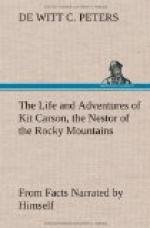Early in the month of February, 1855, Col. T.T. Fauntleroy of the First Regiment of United States Dragoons arrived in Taos from Fort Union, New Mexico.
Fort Union is the first post met with on entering the Territory of New Mexico from the east. It lies on the Santa Fe road usually traveled by parties when crossing the plains, and is about one hundred miles distant from the capital. The site of this fort, at the first view, is bold and picturesque, as it is located near the west side of a broad valley, which is continuous with the open prairies. The houses composing the fort are built mostly of logs; and, as there are quite a number of them, the post has the appearance of a small settlement. The soil about is sandy, and the place being exposed, it suffers when the high winds spring up. This fort is usually garrisoned by several companies of soldiers.
As it has such free access to the mail communication with the States, it is, comparatively speaking, quite a desirable fort for an officer to be stationed at. The difficulty of procuring fuel for the fort, and also other necessary articles, is the great objection to the present location, but its importance more than counterbalances these; therefore, the post will probably be kept up either where it is, or in the immediate vicinity, for many years to come. Colonel Fauntleroy had received orders from the Department General to proceed to the town of Taos and take command of the entire expedition. The little force had been made as powerful as the resources of the country would permit. The Mexican Volunteers, soon after their enrollment, purchased woolen shirts and felt hats, the color of which, in each company, was similar; this fact, with a little drilling, gave them quite a military appearance. Never were men prouder of the position they now held than the volunteers under consideration; and a more daring and expert band of horsemen has been seldom collected. So pleased were they at being recognized as soldiers, that they could not, when afterwards marching through their own towns, resist the temptation of jocosely taunting their countrymen whom they chanced to meet, for being obliged to till the ground. We have before said that these men were mounted. At first sight it would appear as though they would soon be on foot, for their horses appeared to be in a sad plight for so severe a campaign as that which lay before them. As has often occurred before, looks are frequently deceptive. In this instance, it was found to be the case; for, no sooner did these hardy ponies reach the mountains than their wonderful powers of endurance began to be exemplified. When the noble dragoon horses began to droop from hunger and overwork, these little fellows were fresh and strong as the day they started. The reason of this was that the Mexican horses were well versed in taking care of themselves, and when the snow fell and prevented their having free access to the dry grass beneath, they were not in the least disconcerted; for, with the aid of their fore feet, they readily pawed the snow away and thus obtained full rations; but, their more enlightened rivals did not fully understand this science, and, owing to a want of proper nourishment, their strength would fail gradually until finally they broke down.




